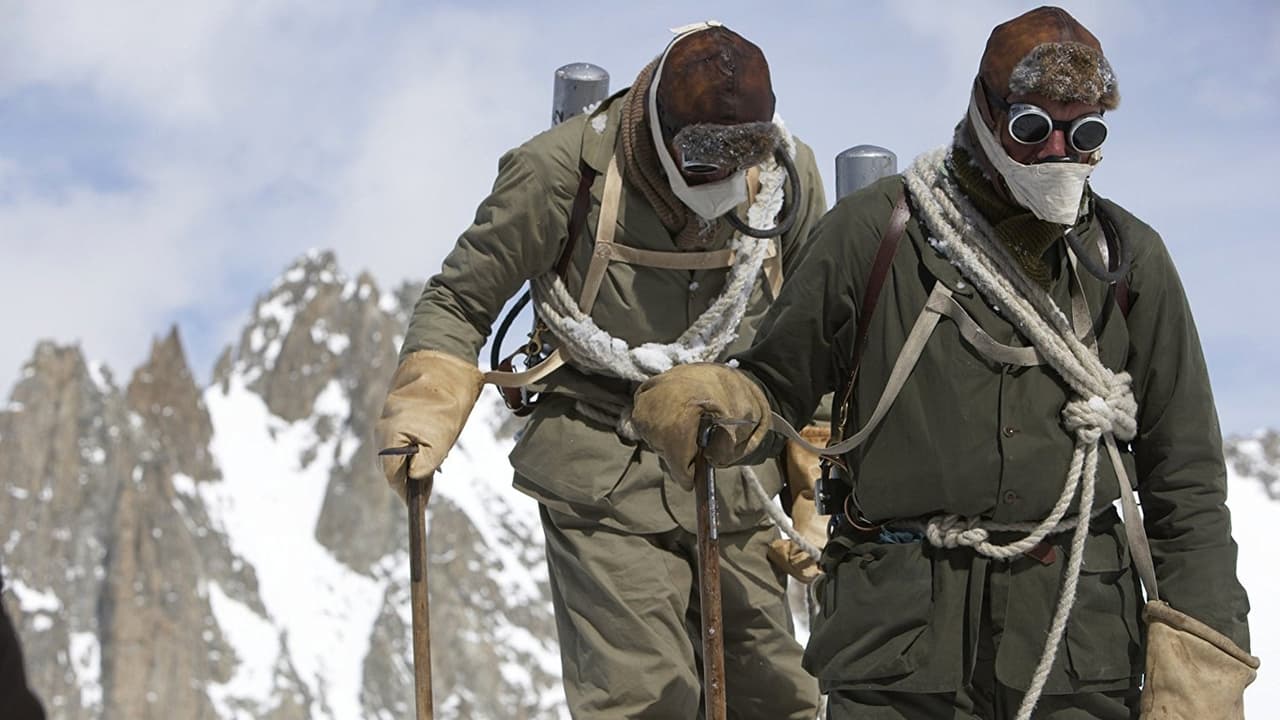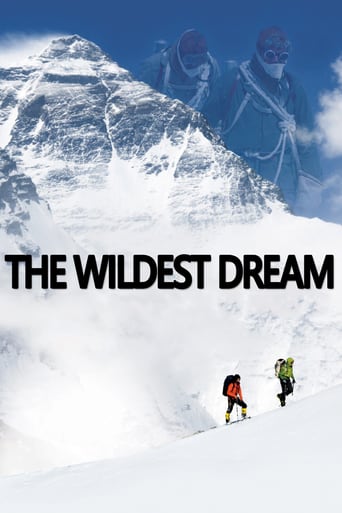

Surprisingly incoherent and boring
... View MoreIt's a mild crowd pleaser for people who are exhausted by blockbusters.
... View MoreTells a fascinating and unsettling true story, and does so well, without pretending to have all the answers.
... View MoreThis is a dark and sometimes deeply uncomfortable drama
... View MoreModern documentary retracing George Mallory's 1924 Mt Everest attempt, which ended in his and his companion's disappearance. His frozen body, with compound fracture, was found in 1999.1924 was near the end of the glory years of the old explorers. Both poles, darkest Africa, perfumed Asia, tropical South America, all have been trekked. Only that peak remained to be claimed.Two modern climbers retraced Mallory's path, wearing layered clothing, fur hats, hobnail boots, goggles.The ladder, placed near the top in the 70s (and used since by countless handicapped, overweight, blind wannabee mountaineers) was removed.Film swings back and forth between Mallory, his letters, the 20s and the difficulties the modern duo encounter.Cold is ever present, and caused one viewer in the room to move closer to the fire.
... View MoreStories of mountaineering and of Everest have always fascinated me. So often, facts make better stories than fiction, and this is another example. I first remember hearing about the discovery of George Mallory's body on what turned out to be a PBS/NOVA special "Lost on Everest" made shortly after the discovery of his body by Conrad Anker, which shows the actual footage of the discovery. The story of George Mallory and Andrew Irvine is overshadowed by the story of Sir Edmond Hillary, who is the first person to officially summit Everest. Mallory and Irvine's story and efforts are no less dramatic considering they attempted the summit 30 earlier, along a more difficult route. Even if they did not succeed in reaching the summit, the fact that they were 800 feet within the summit is in itself astounding. Using up to date technology and filming techniques, along with rarely seen archival footage, this documentary complements the story and narration, and the repeat attempt along the same route replicating similar conditions back then are equally dramatic. Along with "Touching the Void", "The Beckoning Silence" and the current Nova special "Chasing Shackleton" captures the adventurous spirit of the Golden Age of Exploration.
... View MoreWhat happened to British climbers George Mallory and Andrew Irvine after their associate Noel Odell saw them disappear into the clouds on Mt. Everest's Northeast Ridge has been perhaps mountaineering's greatest mystery. Wildest Dream begins with the discovery of George Mallory's frozen body on the North Face of Mount Everest. Conrad Anker, who made the discovery, felt compelled to learn about Mallory, and eventually decided to re-create Mallory's last climb, in order to answer the enduring question, Could Mallory and his companion Sandy Irvine have reached the summit? Using archival footage and photographs, letters between Mallory and his wife Ruth, and interviews with Mallory's granddaughter and Irvine's great niece, the film traces Mallory's life and his role in the British Everest expeditions of 1921 and 1922, as well as the fatal 1924 expedition. Combined with this is the story of Anker's 2007 attempt to repeat Mallory's final climb. As Mallory had selected the athletic, but inexperienced Irvine as his climbing partner, Anker chose the similarly athletic but inexperienced Leo Houlding to accompany him. Of course, Anker enjoyed many advantages that history denied to Mallory. Nonetheless, during his attempt to climb the second of three steps (large rock outcroppings) along Mount Everest's Northeast Ridge, Anker slipped. Thus, in a film about how Mallory and Irvine fell to their deaths, we come chillingly close to seeing Anker and Houlding fall to their deaths. Wildest Dream passes over some of the more gruesome aspects of the story—the fact that a rock had punctured a hole in Mallory's skull during his fall, perhaps killing him, and the presence, in this same area, of 17 other bodies. But its major flaw—and, because it seeks to establish what actually happened, it is a major flaw—is its implied conclusion that if Mallory and Irvine mastered the Second Step they must have reached the summit. In fact, the film neglects much of the evidence from their last hours. For example, there is a variation of opinion about the Second Step. In 1995, Mallory's grandson pronounced it "easy" and climbed it without trouble. Apart from that, Mallory, who had no experience climbing under the conditions on the Northeast Ridge, may well have overestimated the speed with which they could reach the summit. In any case, he may have underestimated the amount of oxygen they would need, perhaps thinking that if they each carried two oxygen tanks, rather than three, they would be better able to "rush the summit." Students of the 1924 expedition have expatiated at length on evidence relating to Mallory and Irvine's final summit attempt. One key piece of evidence is the 12:50 p.m. sighting of the pair by Noel Odell. If they had reached only the First Step by that time, they were seriously behind schedule; but, if they had reached the Third Step (at the base of the final pyramid), their prospects for reaching the summit were excellent. Unfortunately, Odell changed his account over time, so we do not know for certain on which of three steps he saw Mallory and Irvine. Another piece of evidence is Mallory and Irvine's oxygen supply. The conventional assumption seems to be that they each had two full oxygen bottles--at the maximum rate, that would have provided them with oxygen for about 8 hours. In this scenario, their oxygen would have been exhausted before they reached the summit, perhaps before they reached the Third Step, quite possibly forcing them to turn back. But others have argued that Mallory and Irvine each had a partially full oxygen bottle in addition to two full ones, enough perhaps to get them to the summit or close to it. But again, unfortunately, we do not how much oxygen they had; nor can we be sure that all their oxygen bottles were functioning (many had leaked or malfunctioned). More generally, many modern climbers allow 12 hours for the ascent from their high camp to the summit. British climbers on the 1924 expedition seem not have begun their climbs until about 6:00 a.m. Following such a late start, Mallory and Irvine would not have reached the summit until late afternoon. And it would have been dark at 7:00 p.m. At some point, it may have become clear to Mallory, even if he still had oxygen, that he could not summit and still descend in daylight--and some modern climbers have concluded that it is impossible to descend the Second Step in darkness. In this situation, would Mallory have yielded to his urge to summit, or turned back in recognition of his responsibility to his companion and his wife? Since Mallory intended to place a photograph of his wife on the summit, its absence from his personal effects has been adduced as evidence that he did reach the summit. But it seems quite possible that Mallory left Ruth's picture, not at the summit, but at the highest point that he did reach, knowing that she was more anxious to have him back alive than to have her photograph on the summit. (As an example of how far the existing evidence can be pushed, there is also a theory that Mallory appropriated whatever oxygen was available for his own solo attempt on the summit, and told Irvine to return to the high camp or wait along the route.) Wildest Dream provides a good portrait of Mallory and his climbing career. But it does not persuade this reviewer that Mallory reached the summit of Mount Everest.
... View MoreConrad Anker is the steely-eyed hero of the film... The man who discovers Mallory's body takes 8 years to return to the ogre that is Everest to attempt to close the circle on that climber's third and final attempt to summit. To make possible the fulfillment of Mallory's promise to his wife. Its an intensely personal quest for Anker. The man has married his best friend's widow, adopted her three children, and cannot fail. And there is a moment that it seems Anker too may slip into the void. Get lost in the clouds. A planned but organic symmetry between Conrad Anker and George Mallory's climbs emerges, filmed in breathtaking detail with great voice acting.
... View More